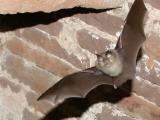Researchers who conducted blood tests on animals from different regions found evidence that camels have been exposed to the Middle East respiratory syndrome coronavirus (MERS-CoV) or a very close relative, the outbreak's first strong clue about a possible animal reservoir.
Until now, the only animal clue has been from genetic sequencing studies, which suggested the virus came from bats. Though there are no reports that any of the patients had contact with bats, a man from the United Arab Emirates who was treated for his fatal infection in Germany had been exposed to a sick racing camel.
The investigators, mostly from the Netherlands and Germany, reported their findings today in The Lancet Infectious Diseases.
The first MERS-CoV illness was reported a year ago, and so far 94 cases and 46 deaths have been confirmed by the World Health Organization (WHO), all of them from or linked to Middle Eastern countries.
Human-to-human infections have been rare, and health officials suspect that an animal reservoir could be playing a yet unknown key role in the spread of the new virus.
The research team obtained 349 blood serum samples from livestock animals including dromedary camels, cows, sheep, goats, and other animals closely related to dromedaries. The animals were from different areas, including Oman, the Netherlands, Spain, and Chile.
They analyzed the blood samples for antibodies to MERS-CoV, other antibodies that react to SARS (severe acute respiratory syndrome) coronavirus, and HCoV-OC43, another strain of coronavirus that can infect humans and is related to a bovine form of the virus.
No cross-reactivity was seen between MERS-CoV antibodies and those for SARS or HCoV-OC43, and the team confirmed those findings with highly specific virus neutralization tests. Presence of MERS-CoV antibodies probably shows previous infection with MERS-CoV, or a closely related virus, the group reported.
No MERS-CoV antibodies were found in the blood of 160 animals from the Netherlands and Spain, but evidence of earlier exposure to the virus was found in all 50 samples taken from dromedary camels in Oman. Sampling in Oman involved camels from different parts of the country, suggesting that MERS-CoV or a close relative is circulating widely in the region's dromedary camels, the authors reported.
No antibodies were found in animals from the Netherlands and Chile that are closely related to dromedaries, such as Bactrian camels, alpacas, and llamas.
Lower levels of MERS-CoV antibodies were found in 14% (15) of samples taken from two herds of dromedaries from the Canary Islands, a Spanish island group located off the coast of mainland Africa that has not reported any human MERS-CoV cases.
The authors said in a journal press release that the dromedaries from Oman were positive more often and had much higher antibody MERS-CoV antibody levels than the ones from Spain. "The best way to explain this is that there is a MERS-CoV-like virus circulating in dromedary camels, but that the behavior of this virus in the Middle East is somehow different to that in Spain," they noted.
The findings suggest dromedary camels may be one reservoir for MERS-CoV and that their popularity in the Middle East, where they are used for racing, meat, and milk, presents a variety of contacts with humans that could lead to virus transmission, the investigators said in the press release.
Surprising findings in Spanish camels
Marion Koopmans, DVM, PhD, study coauthor and a virology expert with the National Institute of Public Health and the Environment in the Netherlands, told CIDRAP News that the group did its best to validate the findings and rule out cross-reactivity, but the final proof will need to come from finding the virus in the camels.
She said researchers redesigned the serology method that they had originally developed for testing in humans for use in testing animals that are common in the area and might have contact with people. "We did not expect to find any antibodies in camels from other regions (Spain), so that was a surprise," she said.
If the antibody evidence is confirmed by finding the virus in the animals, the presence of the virus in both regions—Spain and Oman—suggests that MERS-CoV either is or has been a camel virus or is repeatedly and independently transmitted to the animals by, for example, bats, Koopmans said.
The difference in seropositivity rates and antibody levels between camels in the two regions, though based on limited data and samples, raises questions if confirmed, she said. Oman and the Canary Islands could have different profiles in their animal management, such as rapid turnover due to food production, importations, or international contacts through racing, or differences in the viruses.
The study group is discussing the possibility of further studies with people in different countries that would include samples from cattle, goats, and sheep for both serology and virus testing, Koopmans said.
Experts weigh impact of study
In a commentary in the same issue today, two scientists from the National Institute of Allergy and Infectious Disease (NIAID) Rocky Mountain Laboratories in Hamilton, Mont., said the study raises many questions but is an important step in understanding the emergence of the MERS-CoV virus. They are Emmie de Wit, PhD, with the disease modeling and transmission unit, and Vincent Munster, PhD, with the virus ecology unit.
They wrote that it's unclear if the camels were infected with MERS-CoV or a close relative and noted that so far no human infections have been reported from Oman. However, the high prevalence of neutralizing antibodies, detection of similar sequences in bats across much of the world, and evidence of exposure in Canary Islands camels suggest that MERS-CoV–like viruses have a wide geographic distribution. They add that, because the clinical disease isn't evident in camels, the virus could circulate undetected.
Though it's not clear if evidence of exposure in camels from both Oman and the Canary Islands resulted from cross-species transmission or shows that the virus has been circulating for a long time, a change in the ecology of MERS-CoV must have occurred, allowing it to spill over to humans, they wrote. The change could have been genetic, or an environmental or agricultural change could have allowed the virus to jump to humans, they added.
The authors said the findings emphasize the need for an integrated one-health approach and for extensive serosurveys across the Arabian peninsula in people, livestock, and wildlife, along with virologic sampling.
Gregory Hartl, a spokesman for the World Health Organization (WHO), told CIDRAP News that the study provides clues and a path for further investigation, but the most critical question remains to be answered. "That is, the type of human exposures that result in infection," he said.
Investigations should continue on a variety of species and possible human exposures until public health officials have a clearer idea of how humans contract the disease, Hartl said.
"It is premature to focus solely on camels at this point to the exclusion of other animal investigations, including other livestock, pets, birds, and rodents," he said. "It is also possible that the virus will be identified in an animal species without that species of animal posing any public health risk."
Without knowing the source of the virus or its mode of transmission, health officials aren't yet able to give specific advice on infection prevention, Hartl added.
Reusken CB, Haagmans BL, Muller MA, et al. Middle East respiratory syndrome coronavirus neutralizing serum antibodies in dromedary camels: a comparative serological study. Lancet Infect Dis 2013 Aug 8 [Abstract]
deWit E, Munster VJ. MERS-CoV: the intermediate host identified? (Commentary) Lancet Infect Dis 2013 Aug 8 [Extract]
See also:
Aug 8 Lancet Infect Dis press release



















